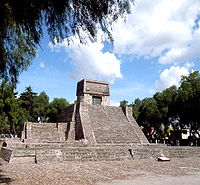Portal:Indigenous peoples of the Americas
Discover Wikipedia using portals
Portal maintenance status: (June 2018)
|
The Indigenous peoples of the Americas PortalCurrent distribution of Indigenous peoples of the Americas The Indigenous peoples of the Americas are groups of people native to a specific region that inhabited the Americas before the arrival of European settlers in the 15th century and the ethnic groups who continue to identify themselves with those peoples. The Indigenous peoples of the Americas are diverse; some Indigenous peoples were historically hunter-gatherers, while others traditionally practice agriculture and aquaculture. In some regions, Indigenous peoples created pre-contact monumental architecture, large-scale organized cities, city-states, chiefdoms, states, kingdoms, republics, confederacies and empires. These societies had varying degrees of knowledge of engineering, architecture, mathematics, astronomy, writing, physics, medicine, planting and irrigation, geology, mining, metallurgy, sculpture and gold smithing. (Full article...) Selected article The Aztec /ˈæztɛk/ people were certain ethnic groups of central Mexico, particularly those groups who spoke the Nahuatl language and who dominated large parts of Mesoamerica from the 14th to 16th centuries. The Nahuatl words aztecatl [asˈtekat͡ɬ] (singular) and aztecah [asˈtekaʔ] (plural) mean "people from Aztlán", a mythological place for the Nahuatl-speaking culture of the time, and later adopted as the word to define the Mexica people. Often the term "Aztec" refers exclusively to the Mexica people of Tenochtitlan (now the location of Mexico City), situated on an island in Lake Texcoco, who referred to themselves as Mēxihcah Tenochcah [meːˈʃiʔkaʔ teˈnot͡ʃkaʔ] or Cōlhuah Mexihcah [ˈkoːlwaʔ meːˈʃiʔkaʔ]. Sometimes the term also includes the inhabitants of Tenochtitlan's two principal allied city-states, the Acolhuas of Texcoco and the Tepanecs of Tlacopan, who together with the Mexica formed the Aztec Triple Alliance which controlled what is often known as the "Aztec Empire". In other contexts, Aztec may refer to all the various city states and their peoples, who shared large parts of their ethnic history and cultural traits with the Mexica, Acolhua and Tepanecs, and who often also used the Nahuatl language as a lingua franca. In this meaning it is possible to talk about an Aztec civilization including all the particular cultural patterns common for most of the peoples inhabiting Central Mexico in the late postclassic period. Selected image "Montezuma´s Castle" in Arizona, from the Sinagua culture dating to 1000 years ago image credit: Tomas Castelazo
General imagesThe following are images from various Indigenous peoples of the Americas-related articles on Wikipedia.
Selected biography Rigoberta Menchú Tum (Spanish pronunciation: [riɣoˈβerta menˈtʃu], born 9 January 1959) is an indigenous Guatemalan woman, of the K'iche' ethnic group. Menchú has dedicated her life to publicizing the plight of Guatemala's indigenous peoples during and after the Guatemalan Civil War (1960–1996), and to promoting indigenous rights in the country. She received the 1992 Nobel Peace Prize and Prince of Asturias Award in 1998. She is the subject of the testimonial biography I, Rigoberta Menchú (1983) and the author of the autobiographical work, Crossing Borders. Menchú is a UNESCO Goodwill Ambassador. She has also become a figure in indigenous political parties and ran for President of Guatemala in 2007 and 2011. Did you know…
SubcategoriesRelated portalsThings you can do
Selected panoramaTopics
Recognized content
Featured articlesFormer featured articlesGood articles
Former good articlesDid you know? articles
In the News articlesAssociated WikimediaThe following Wikimedia Foundation sister projects provide more on this subject:
American indigenous language WikipediasAvañe'ẽ (Warani) · Aymar aru (Aymara) · ᏣᎳᎩ (Cherokee) · Chahta (Choctaw) · ᐃᔨᔫ (Cree) · ᐃᓄᒃ (Inuktitut) · Iñupiak · Kalaallisut (Greenlandic Inuit) · Mvskoke (Muscogee) · Nahuatlahtolli · Diné bizaad (Navajo) · Qhichwa Simi · Tsêhesenêstsestôtse (Cheyenne) Indigenous languages in Wikimedia Incubators: Alabama · Blackfoot · Chinook Jargon · Choctaw · Creek · Lakota · Micmac · Mohawk · Nheengatu · Northwestern Ojibwa · O'odham · Shoshoni · Unami-Lenape · Wüne pakina (Mapudungun) · Yucatec Maya · Central Alaskan Yup'ik · Zuni | |||||||||||||||||||||||||||||||||||||



